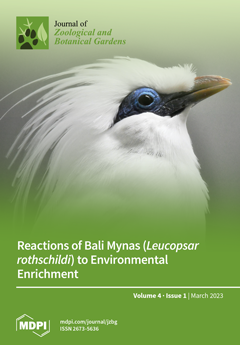It is important to examine the animal welfare implications of all aspects of zoo operations, including out-of-hours public events. Research to date has indicated variable responses across species and event types. The current research aimed to understand and quantify the impact of a
[...] Read more.
It is important to examine the animal welfare implications of all aspects of zoo operations, including out-of-hours public events. Research to date has indicated variable responses across species and event types. The current research aimed to understand and quantify the impact of a Christmas lights event. Four species: Rothschild giraffe (
Giraffa camelopardalis rothschildi;
n = 2) in one exhibit and capybara (
Hydrochoerus hydrochaeris;
n = 4), lowland tapir (
Tapirus terrestris;
n = 3) and vicuña (
Lama vicugna;
n = 5) in a mixed species exhibit were observed. Data were collected from 16:00–20:00 between 28 October 2021 and 11 January 2022. The event ran from mid-November to the end of December 2021. Five-minute behavioural observations were undertaken once per hour using instantaneous scan sampling with a one-minute inter-scan interval. A further six days of 12 h observations were conducted to enable a more detailed investigation post-event. Data collected were compared on non-event and event days using Mann–Whitney U tests (event vs. non-event) and Kruskal–Wallis tests (pre-event, event, post-event periods). Kruskal–Wallis tests and one-way ANOVAs were undertaken to compare behaviours during three time periods (12:00–16:00, 16:00–20:00, 20:00–00:00) over 12 h. Mixed behavioural responses were seen across the study species. Capybara spent more time in their house from 16:00–20:00 on event nights compared to non-event nights (
p < 0.001) and tapir only engaged in vigilant behaviour from 16:00–20:00 when the event was held, (
p = 0.044). There were no differences in frequency of behaviour between pre-event, event, and post-event observation periods, with the exception of capybara, who spent more time OOS in the pre-event period than during (
p < 0.001) or after the event (
p < 0.001). The results of the project, undertaken as part of an evidence-based management programme, highlighted that the event did not have any overtly negative impacts on the individuals studied. Except for the giraffe, all individuals had free access to inside and outside environments, and it is believed this choice enabled animals to be active in managing their response to the event. It is recommended that future work observe animals over 24 h to understand whether events lead to behavioural changes the day after events or if animals reverted to normal activity once the event ended.
Full article





